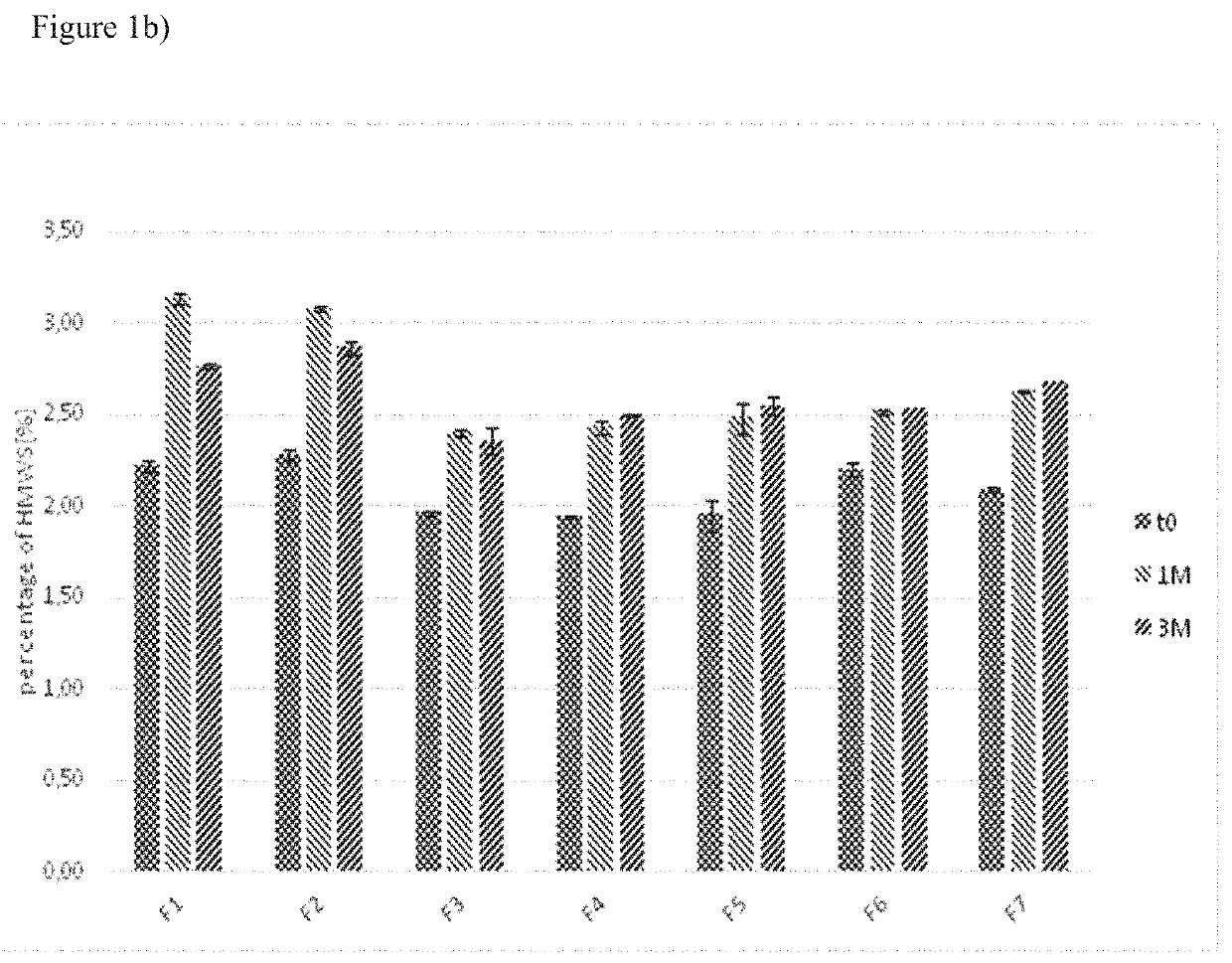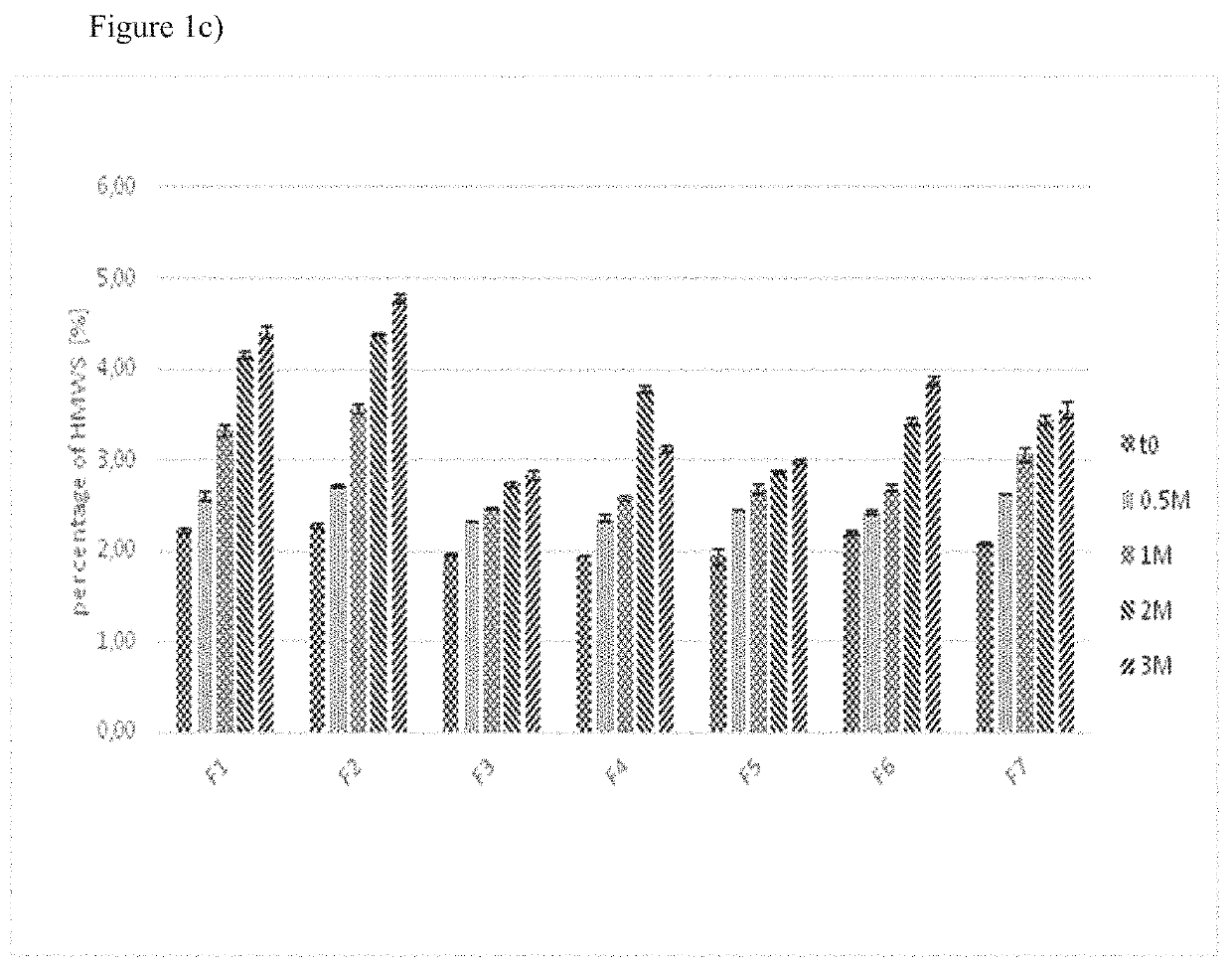Liquid formulation of a VEGF antagonist
a technology of vegf antagonist and liquid formulation, which is applied in the direction of drug compositions, peptide/protein ingredients, inorganic non-active ingredients, etc., can solve the problems of decreasing the content of active ingredients, and achieve the effect of reducing costs and producing in a shorter tim
- Summary
- Abstract
- Description
- Claims
- Application Information
AI Technical Summary
Benefits of technology
Problems solved by technology
Method used
Image
Examples
example 1
First Set of Stability Tests
Example 1.1
Preparation of Samples
[0123]Different formulations of aflibercept were prepared according to Table 1.
[0124]
TABLE 1Pharmaceutical compositions tested. Sample 7 corresponds to thecommercially available aflibercept (Eylea ®) formulation.bufferinorganic saltsurfactantcarbohydrate110 mM sodium citrate,40 mM NaCl0.03% PS 20 5% sucrosepH 6.2210 mM sodium citrate,—0.03% PS 2010% sucrosepH 6.2310 mM L-His / HisHCl;40 mM NaCl0.03% PS 20 5% sucrosepH 6.2410 mM L-His / HisHCl;—0.03% PS 2010% sucrosepH 6.2510 mM L-His / HisHCl;40 mM NaCl0.03% PS 20 5% sucrosepH 6.5610 mM L-His / HisHCl;150 mM NaCl 0.01% PS 20—pH 6.2710 mM sodium40 mM NaCl0.03% PS 20 5% sucrosephosphate; pH 6.2All pharmaceutical compositions listed above contained 40 mg / ml of aflibercept.
[0125]The pharmaceutical compositions were prepared without aflibercept, which was dialyzed into them afterwards. The excipients sucrose, potentially sodium chloride and the surfactant polysorbate 20 were dissolved ...
example 1.2
Test Conditions
[0127]To identify the most stable formulation the samples were analyzed after subjecting them to different conditions.
[0128]In one set of experiments, the samples were subjected to different stress conditions. These stress conditions were chosen to force the chemical and physical degradation pathways of aflibercept and included the following conditions:[0129]a) shaking (samples were shaken with 300 rpm at 25° C. for 7 days), and[0130]b) freeze / thaw (samples were frozen and thawed three times (25° C. to −20° C.) with a rate of ±1° C. / min; after each cooling / heating step the temperature (25° C. and −20° C. respectively) was kept constant for 10 minutes).
[0131]In another set of experiments, the samples were stored at a temperature of 5° C. for one or three months or at temperatures of 25° C. and 60% relative humidity or 40° C. and 75% relative humidity for two weeks, one, two or three months.
[0132]After the samples had been subjected to the different conditions as outlin...
example 1.3
Analysis by Size Exclusion Chromatography
[0133]Size exclusion chromatography was employed to detect high molecular weight species (HMWS), i.e. aggregates of aflibercept.
[0134]Size exclusion chromatography (SEC) uses porous particles to separate molecules of different sizes. It is generally used to separate biological molecules according to their molecular mass and shape in diluted solution. The stationary phase consists of spherical porous particles of controlled pore size through which biomolecules diffuse to different extents based on differences in their molecular sizes. Small molecules diffuse freely into the pores and their movement through the column is retarded, whereas large molecules are unable to enter the pores and are therefore eluted earlier. Hence, molecules are separated in order of decreasing molecular mass, with the largest molecules eluting from the column first.
[0135]The samples of the stability program were diluted with SEC eluent to a final concentration of 0.5 ...
PUM
| Property | Measurement | Unit |
|---|---|---|
| concentration | aaaaa | aaaaa |
| pH | aaaaa | aaaaa |
| pH | aaaaa | aaaaa |
Abstract
Description
Claims
Application Information
 Login to View More
Login to View More - R&D
- Intellectual Property
- Life Sciences
- Materials
- Tech Scout
- Unparalleled Data Quality
- Higher Quality Content
- 60% Fewer Hallucinations
Browse by: Latest US Patents, China's latest patents, Technical Efficacy Thesaurus, Application Domain, Technology Topic, Popular Technical Reports.
© 2025 PatSnap. All rights reserved.Legal|Privacy policy|Modern Slavery Act Transparency Statement|Sitemap|About US| Contact US: help@patsnap.com



